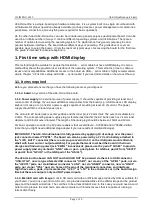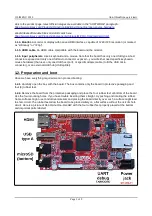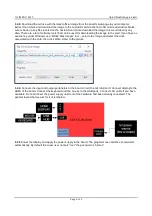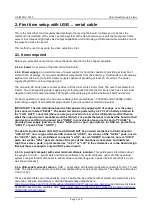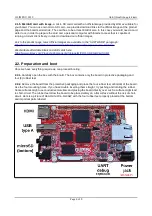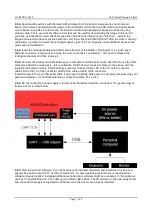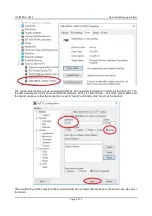
OLIMEX© 2019
A64-OLinuXino quick start
2.2.3.
Download the archive with the latest official image from the board's web-page to your computer.
Extract the archive and download the image to the microSD card via the microSD card reader/writer. Make
sure to back-up any files located on the microSD card since downloading the image would destroy any
previous data.
There are a lot of software tools that can be used for downloading the image to the card. If
you have no experience under Windows use either “Win32 Disk Imager” tool or “Ethcher” – point to the
image and select the drive associated with the card, then click Write. IMPORTANT! After the write is nearing
completion, a prompt to format the card might appear, ignore it! This happens under Windows because the
card ends up formatted in
2.2.4.
Insert the already prepared microSD card in the slot at the bottom of the board.
It is a push-push
MicroSD connector. If you want to remove the card, do not pull it out directly – first push to release the
locking mechanism and then remove it.
2.2.5.
Connect the USB-serial cable between your computer and the board. At the board's side use the three
male pins behind the power jack – this is called the “UART debug” connector. Refer to the picture with the
layout of the board on where “UART debug” is located. Connect cable's RX to the TX of the connector;
cable's RX to the TX of the connector; GND of the cable ot GND of the connector.
Install the drivers for your USB-serial cable if you haven't already. Make sure it is properly recognized by your
personal computer – it should be listed as a serial port (COMx; TTYx; etc).
2.2.6.
Do not connect the power supply until rest of the hardware had been connected. The general layout
that we aim for is listed below:
2.2.7.
Start the terminal software. If you don't have such installed, download and install such for free, few
popular free options are PuTTY, TeraTerm, RealTerm.
In some operating system there is serial terminal
software already installed, installing additional serial terminal software might be redundant.
In this guide we
use PuTTY and Windows 10. The cable used is Olimex BB-CH340. The first picture on the next page shows
how the serial cable gets recognized by Windows once the drivers are properly installed:
Page 7 of 9


